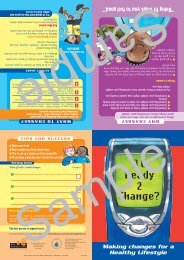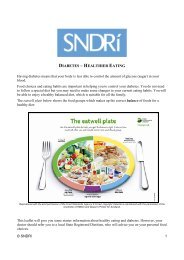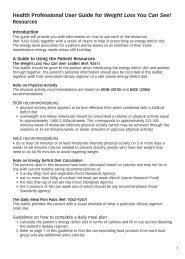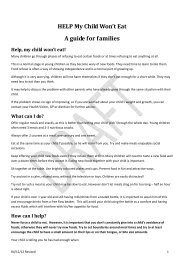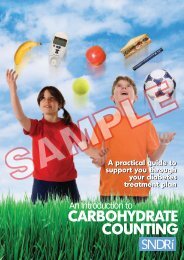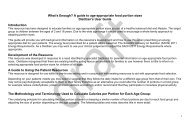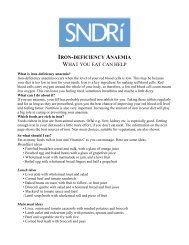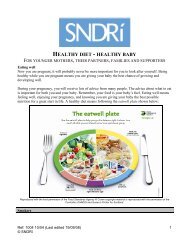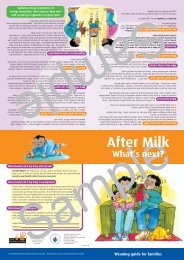Cardio-protective Diet for You - NDR-UK
Cardio-protective Diet for You - NDR-UK
Cardio-protective Diet for You - NDR-UK
You also want an ePaper? Increase the reach of your titles
YUMPU automatically turns print PDFs into web optimized ePapers that Google loves.
<strong>Cardio</strong>-<strong>protective</strong> <strong>Diet</strong> <strong>for</strong> <strong>You</strong><br />
This leaflet explains the risk factors <strong>for</strong> developing heart disease and provides advice on reducing<br />
these risks.<br />
People living with HIV have higher rates of heart disease than the general population. This may be<br />
caused by the virus, ARVs and general risk factors.<br />
What can increase my chances of developing heart disease?<br />
There are a number of risk factors <strong>for</strong> heart disease, <strong>for</strong> example:<br />
• having a raised total cholesterol, high LDL cholesterol or a low HDL cholesterol<br />
• smoking<br />
• lack of exercise<br />
• being overweight, obese or having an increased waist size<br />
• having high blood pressure<br />
• having diabetes<br />
• being male<br />
• having a family history of premature heart disease<br />
• being of South Asian ethnicity.<br />
Cholesterol<br />
Cholesterol is made by the liver. It is used as the building blocks of hormones and <strong>for</strong>ms important<br />
molecules within your cells. Some foods contain cholesterol, but this normally has only a very<br />
small effect on your cholesterol levels.<br />
• LDL cholesterol<br />
This is often call ‘bad cholesterol’. It leads to build-up on your artery walls causing them to<br />
narrow. It is important to try to keep your LDL figure low to prevent blockage of your<br />
arteries.<br />
• HDL cholesterol<br />
This is often call ‘good cholesterol’. It helps to prevent build-up on your arteries. It is<br />
important to try to keep your HDL figure high.<br />
• Total cholesterol<br />
Total cholesterol this is the combined figure <strong>for</strong> all the different types of cholesterol in your<br />
blood stream. <strong>You</strong> should try to keep this low.<br />
• Total cholesterol:HDL cholesterol ratio<br />
Sometimes your total cholesterol maybe high but your ratio is still ok. This is better than<br />
both being high.<br />
Triglycerides<br />
Triglycerides are another type of fat in your blood. Increased triglyceride levels can be associated<br />
with being overweight (especially large waist size), having a diet high in sugar and/or alcohol,<br />
being inactive and having poorly controlled diabetes. The higher your triglyceride level, the more<br />
‘sticky’ your blood and the greater the risk of a clot <strong>for</strong>ming. It is important to try to keep your<br />
figure low.<br />
120404Heart Health <strong>for</strong> HIV DRAFT<br />
1
Guidelines <strong>for</strong> blood fat levels<br />
Most centres have their own guidelines <strong>for</strong> target cholesterol levels. Ask your doctor, nurse or<br />
dietitian what these are and compare them to your own levels in the table below.<br />
<strong>You</strong>r measurements<br />
Measurement Local guidelines <strong>You</strong>r results<br />
Total Cholesterol<br />
LDL<br />
HDL<br />
Ratio TC: HDL<br />
Triglycerides<br />
<strong>Cardio</strong>vascular risk assessment<br />
<strong>You</strong>r consultant, specialist nurse or dietitian is likely to give you an annual ‘<strong>Cardio</strong>vascular risk<br />
assessment’. They will consider in<strong>for</strong>mation including your age, gender, family history, lifestyle<br />
and blood fat levels to calculate your risk of developing cardiovascular disease within the next ten<br />
years.<br />
Ask your healthcare team <strong>for</strong> more in<strong>for</strong>mation if you are interested in knowing more.<br />
Medication <strong>for</strong> cholesterol and triglycerides<br />
If your cholesterol remains high after you have made diet and lifestyle changes, your doctor and<br />
dietitian may suggest you take medication to help lower your cholesterol. Usually a statin will be<br />
prescribed, but fibrates or ezetimibe may be used. If your GP decides to start you on statin<br />
medication, it is important to ask your HIV consultant or pharmacist if this is suitable as some<br />
statins may interact with your anti-retroviral therapy. <strong>You</strong>r doctor may also consider switching<br />
your ARV if it is known to raise cholesterol levels.<br />
Improving your diet can reduce your cholesterol levels and lower risks of developing heart<br />
disease<br />
A better diet could improve your cholesterol levels and help decrease your risks of developing<br />
heart disease. Even small changes in your cholesterol are likely to help improve your long-term<br />
health.<br />
Fat<br />
Not all fats are equal. The effect of different types of fat on your cholesterol levels are described<br />
below.<br />
To lower your cholesterol levels, it is important to try and reduce the overall amount of fat in your<br />
diet – healthy fats should also only be used in small amounts.<br />
• Saturated Fat<br />
A reduction in total saturated fat intake can reduce your cholesterol levels. Generally<br />
saturated fat is found in products which come from animals. Foods very high in saturated<br />
fat include fatty cuts of red meat, the skin from poultry, full-fat dairy products like full-fat<br />
milk or ice cream, animal-based cooking fats like butter, ghee, lard, dripping and products<br />
120404Heart Health <strong>for</strong> HIV DRAFT<br />
2
made from these including pastries, pies, samosas. There are a few plant-based foods high<br />
in saturated fat, including coconut cream, coconut oil and palm oil (or red oil).<br />
Sources of saturated fat and how to reduce your intake<br />
Saturated fat<br />
How to reduce these<br />
Visible white fat on meat. • Reduce red meat and choose lean cuts.<br />
Poultry with its skin.<br />
• Reduce processed meat products such as sausages,<br />
burgers, salami, meat balls.<br />
• Remove visible fat be<strong>for</strong>e cooking.<br />
• Grill meat to allow fat to drain off.<br />
• Remove skin from poultry.<br />
Butter, ghee, dripping, lard,<br />
palm kernel oil, palm oil,<br />
coconut oil.<br />
Mayonnaise, tartar sauce,<br />
Marie rose sauce.<br />
Full-fat milk<br />
Cheese<br />
Cream and full fat crème<br />
fraiche<br />
Coconut oil, coconut cream<br />
Pastries, pasties, pies<br />
• Dry fry mince and drain off the fat be<strong>for</strong>e cooking.<br />
• Swap to a plant-based spread instead of butter or<br />
ghee on bread, chapattis and in baking.<br />
• Use small amounts of unsaturated oils in cooking<br />
instead of butter or lard.<br />
• If certain dishes require a specific oil than try to limit<br />
these.<br />
• Try to use alternative flavourings like lemon juice,<br />
vinegar, natural yoghurt, fat-free dressings.<br />
• If you must continue to use these, swap to low-fat<br />
version and use sparingly.<br />
• Swap to skimmed or semi-skimmed.<br />
• Try to keep to a small portion, about 30g or the size<br />
of a small matchbox.<br />
• Try to only have cheese occasionally and don’t<br />
routinely use it as an extra on top of pasta or baked<br />
beans.<br />
• Choose softer pasteurised cheeses like goat’s cheese<br />
or brie instead of Cheddar or stilton.<br />
• Avoid full-fat cream-based sauces with meat, poultry,<br />
fish and pasta – choose vegetable and tomato<br />
alternatives.<br />
• Use low-fat alternatives in cooking, <strong>for</strong> example lowfat<br />
crème fraiche instead of cream.<br />
• Try low-fat natural yoghurt, fromage frais or crème<br />
fraiche with desserts.<br />
• Use light versions and sparingly.<br />
• If eating foods that frequently use coconut such as<br />
South Indian or Thai cuisine, try to use alternatives<br />
without such as dishes tom yum soup.<br />
• Choose filo pastry rather than short crust if baking at<br />
home.<br />
• Try making your own pastry using an unsaturated<br />
spread (suitable <strong>for</strong> baking).<br />
• Make pastry toppings rather than a whole pie to<br />
120404Heart Health <strong>for</strong> HIV DRAFT<br />
3
Saturated fat<br />
How to reduce these<br />
reduce the amount of pastry used.<br />
• Only have these foods occasionally.<br />
• Trans fats<br />
Trans fat is the most harmful type of fat <strong>for</strong> your heart because it lowers HDL cholesterol<br />
and increases LDL cholesterol.<br />
Trans fat are mainly found in processed foods such as cakes, pastries, biscuits, crackers and<br />
very hard margarines. Very small amounts of trans fat occurs naturally in meat and dairy<br />
products but most comes from processed vegetable oils. Food manufacturers are trying to<br />
change the way they process foods to eliminate these. For example, many major vegetable<br />
oil-based spreads are now trans fat-free.<br />
Limiting the amount of processed high-fat foods in your diet will reduce your trans fat<br />
intake.<br />
• Unsaturated Fat<br />
There are two types of unsaturated fat in the diet. Both are healthier than saturated fat.<br />
Monounsaturated fat<br />
These are the best type of fat as they help to lower LDL cholesterol and leave HDL<br />
cholesterol levels as they are. Typically monounsaturated fats are found in plant-based<br />
foods such as nuts and seeds.<br />
Polyunsaturated fat<br />
These are also a god type of fat, though not quite as good as monounsaturates. They<br />
help to lower LDL cholesterol but may also lower HDL cholesterol. They are found in<br />
similar sorts of foods as monounsaturates and will often both occur in some foods.<br />
Sources of Unsaturated fats<br />
Monounsaturated fats <br />
Olive oil and olive oil based spreads<br />
Rapeseed oil (commonly found in<br />
vegetable oil)<br />
Peanut or ground nut oil<br />
Almonds<br />
Sesame oil<br />
Cashews<br />
Peanuts<br />
Pistachio<br />
Hazelnuts<br />
Avocado<br />
Polyunsaturated fats <br />
Sunflower oil and sunflower spreads<br />
Corn oil and corn oil spreads<br />
Soybean and soybean spreads<br />
Safflower oil<br />
Walnuts<br />
Pine nuts<br />
Sesame seeds<br />
Remember:<br />
- All fat (unsaturated and saturated) has the same amount of calories.<br />
- Replacing saturated fats with unsaturated fats can help to improve your cholesterol<br />
levels.<br />
120404Heart Health <strong>for</strong> HIV DRAFT<br />
4
- If your total fat intake is high or you are overweight, it may be beneficial to reduce<br />
the overall amount of fat in your diet in addition to decreasing your cholesterol.<br />
Tips <strong>for</strong> swapping saturated fats with unsaturated fats<br />
- Replace butter with an olive-oil based spread.<br />
- Use mashed avocado and lemon juice instead of mayonnaise in sandwiches.<br />
- Use olive oil or nut oil dressings instead of mayonnaise-style dressings.<br />
- Add seeds and nuts to dishes such as soups, salads and cereals.<br />
- Snack on nuts and seeds in place of snacks high in saturated fat, but remember to<br />
only eat small quantities if you are trying to lose weight as they are high in calories.<br />
- Use olive oil or vegetable oil <strong>for</strong> cooking in place of butter, lard or ghee.<br />
- Try to substitute butter with vegetable-based spread or oil in baking.<br />
• Fish<br />
Fish can be divided in two groups – white fish and oily fish. Both of these are important<br />
foods to include in your diet in order to keep your heart healthy.<br />
White fish are a very low-fat and low-calorie source of protein. Oily fish contain high levels<br />
of unsaturated fats called omega-3 fats. These help to protect your heart and keep your<br />
blood thin.<br />
Current recommendations <strong>for</strong> the whole population are to include 2 portions of fish (1<br />
portion = 140g) per week with at least one of these being an oily fish. If you have<br />
previously had a heart attack, then this recommendation is increased to 2-3 large portions<br />
of oily fish per week.<br />
Women who are pregnant, breast feeding or likely to become pregnant are advised to limit<br />
their oily fish intake to 2 portions per week or 4 medium-size cans of tuna per week.<br />
Additionally they should avoid eating shark, marlin and swordfish.<br />
Types of fish<br />
Oily fish<br />
White fish<br />
Salmon Trout Cod Canned crab<br />
Mackerel Sprats Bass Rock<br />
Kippers Anchovies Haddock Coley/pollock<br />
Pilchards Skippers Plaice Hake<br />
Sardines Sild Sole Kingfish<br />
Herring Fresh tuna Tilapia Canned tuna<br />
Fresh crab Swordfish<br />
(only have once<br />
per week)<br />
Fish oil supplements and non-fish sources omega-3 fats<br />
If you do not eat fish or oily fish you may want to think about taking a once daily fish oil<br />
supplement. These are available from all pharmacists and health food shops. <strong>You</strong><br />
should look <strong>for</strong> a supplement containing fish body oils specifically docosahexaenoic<br />
acid (DHA) and eicosapentaenoic acid (EPA). Specific amounts of these vary between<br />
120404Heart Health <strong>for</strong> HIV DRAFT<br />
5
ands, but as a guide one capsule should contain 1000mg total omega-3 fats and you<br />
should aim to take 1 of these per day. Discuss this with your dietitian or consultant to<br />
get some advice on what to take. If you are taking medication to reduce the clotting of<br />
your blood (such as warfarin) check with your doctor be<strong>for</strong>e taking a fish oil<br />
supplement. If you are pregnant, check that supplements are suitable.<br />
The body can convert the oils found in flaxseed and flaxseed oil, walnuts and rapeseed<br />
oil into omega-3 fats. If you do not want to take marine fish oils then these foods may<br />
be a suitable alternative, although the benefits of these foods are not fully understood.<br />
• Fruit and vegetables<br />
Fruit and vegetables provide lots of nutrients that help to protect your heart. There<strong>for</strong>e, it<br />
is very important to include these in your diet. Aim to take 5 portions of fruit, vegetables<br />
and salad per day.<br />
Fruit and vegetables are an excellent source of fibre (see p7). They also contain antioxidant<br />
vitamins which can help protect arteries.<br />
Types of fruit and vegetables that count towards your 5-a-day<br />
Fresh fruit and vegetables Frozen fruit and vegetables Fruit and vegetables in<br />
dishes such as soups or<br />
stews<br />
Canned fruit and<br />
vegetables. Choose varieties<br />
in natural juice or water,<br />
with no added sugar or salt.<br />
A smoothie containing<br />
whole fruit and/or<br />
vegetable may count as<br />
more than one portion but<br />
this depends on how it's<br />
made. Smoothies count as<br />
up to a maximum of two<br />
portions per day.<br />
Dried fruit, such as currants,<br />
dates, sultanas and figs.<br />
Beans and pulses. These<br />
only count as one portion a<br />
day, no matter how many<br />
you eat. That's because they<br />
contain fewer nutrients<br />
than other fruits and<br />
vegetables.<br />
A glass (150ml) of<br />
unsweetened 100% fruit or<br />
vegetable juice. Juice counts<br />
as a maximum of one<br />
portion a day, regardless of<br />
how much you drink<br />
because juice contains less<br />
fibre than whole fruits and<br />
vegetables, and more sugar.<br />
Fruit and veg in convenience<br />
foods, such as ready meals<br />
and shop-bought pasta<br />
sauces, soups and<br />
puddings. Some are high in<br />
salt, sugar and fat, so<br />
only have them occasionally<br />
or in small amounts.<br />
What is a portion of fruit and vegetables?<br />
A medium apple, orange, banana.<br />
Two small fruits, <strong>for</strong> example kiwis or plums.<br />
Half a grapefruit, a slice of papaya or melon, 2 slices of mango.<br />
A heaped tablespoon of dried fruits.<br />
150ml pure fruit juice or smoothie made with whole fruit.<br />
A cereal bowl full of salad.<br />
120404Heart Health <strong>for</strong> HIV DRAFT<br />
6
Three heaped tablespoons of cooked vegetables.<br />
Three heaped tablespoons of beans or pulses.<br />
• Fibre<br />
There are two different types of fibre in your diet. Both help heart health.<br />
Insoluble fibre<br />
This is found in pips, skins and seeds of fruits, vegetables and the husks of cereal<br />
products. It is very good <strong>for</strong> your bowel and can help weight loss by making you feel<br />
full.<br />
Soluble fibre<br />
This is found in things like porridge oats, okra, beans and pulses and fruits. It helps to<br />
lower LDL and total cholesterol levels.<br />
• Sources of dietary fibre<br />
Insoluble Fibre<br />
Found in vegetable and fruit skins, pips,<br />
husks and seeds<br />
Pips<br />
Skins of fruits<br />
Wholegrains and wholegrain products (e.g.<br />
breads, cereals, pasta)<br />
Bran and bran products<br />
Stringy vegetables<br />
Nuts<br />
Potato skins<br />
Soluble Fibre<br />
Found inside fruits and vegetables and in<br />
some grains<br />
Oats, rye and barley<br />
Psyllium<br />
Root vegetables and root tubers. carrots,<br />
celeriac, cassava, yam<br />
Beans, pulses and legume<br />
Flesh of apples and pears<br />
Soft fruits and berries<br />
Okra<br />
• Plant stanols and sterols<br />
Stanols and sterols are naturally occurring compounds found in plants that can block the<br />
absorption of some cholesterol. The amount of stanols and sterols found naturally in most<br />
fruits and vegetables are very low, so it would be difficult to eat enough through these<br />
sources to have a significant effect on your cholesterol levels.<br />
Many products <strong>for</strong>tified with high stanols and sterols concentrations are now available.<br />
These include spreads, milks, yoghurt and yoghurt shots. The following table provides<br />
details about products and doses to help you achieve a daily intake to achieve a significant<br />
health effect.<br />
Stanol/Sterol containing products and their recommended doses<br />
Food item<br />
Spreads<br />
Flora proactive low fat spreads (light, olive oil,<br />
extra light)<br />
Benecol ® spreads, regular, olive oil, light)<br />
Asda cholesterol lowering spread<br />
Portion size<br />
10g/2 level<br />
teaspoons<br />
12g/2 slightly<br />
heaped teaspoons<br />
2 level teaspoons<br />
Servings needed to<br />
meet 2g/day<br />
3<br />
3<br />
3<br />
120404Heart Health <strong>for</strong> HIV DRAFT<br />
7
Yoghurts<br />
Flora proactive<br />
Benecol ® low fat bio yoghurt<br />
125g pot<br />
125g pot<br />
Milk<br />
Flora proactive 250mls 3<br />
Cheese<br />
Minocol<br />
Benecol® light cream cheese style spread<br />
Mini yoghurt drinks<br />
Pro X cholesterol lowering<br />
Asda cholesterol lowering<br />
Flora proactive health yoghurt drink<br />
Benecol ®yoghurt drink (light)<br />
Tesco healthy living cholesterol lowering<br />
65g serving /2 small<br />
matchboxes<br />
20g serving/ 4<br />
teaspoons<br />
100g/1 bottle<br />
100g/1 bottle<br />
100g/1 bottle<br />
67.5g/1 mini bottle<br />
100g/1 bottle<br />
Mini smoothie drinks<br />
Benecol ® fruit and dairy smoothie 65.5g/1 mini bottle 1<br />
Mini dairy-free drinks<br />
Benecol ® dairy free mini drink 65.5g/1 mini bottle 1<br />
3<br />
3<br />
3<br />
3<br />
1<br />
1<br />
1<br />
1<br />
1<br />
• Soya<br />
There is some evidence that soya and soya products can lower your cholesterol levels and<br />
there<strong>for</strong>e reduce your risk of heart disease. Taking 25g of soya protein every day can lead<br />
to a small reduction in total cholesterol. The following suggestions are useful choices to<br />
help you meet this daily intake:<br />
1 litre of soya milk<br />
150g tofu<br />
try soya yoghurts<br />
use soya mince instead of meat/poultry mince.<br />
Weight<br />
Being overweight can have a significant effect on your cholesterol levels especially if you carry<br />
your weight around your waist and abdomen. In recent years it has been shown that waist<br />
circumference is a more accurate way of telling whether someone is overweight and at higher risk<br />
of heart disease.<br />
Body mass index (BMI) is a measure used to indicate how healthy your weight is. To calculate your<br />
BMI divide your weight (kg) by your height (m) squared<br />
BMI = weight (kg) ÷ (height (m) x height (m))<br />
BMI is categorised into ranges that indicate how healthy your weight is <strong>for</strong> your height. Health<br />
risks are greater <strong>for</strong> people of Asian ethnicity at a lower weight, so there are different suggested<br />
ranges <strong>for</strong> each BMI category.<br />
Body Mass Index and categories<br />
Underweight Ideal weight Overweight Obese<br />
120404Heart Health <strong>for</strong> HIV DRAFT<br />
Morbidly obese<br />
8
Adults<br />
(general)<br />
Adults of Asian<br />
ethnicity<br />
less than<br />
19.9<br />
Less than<br />
18.5<br />
20-24.9 25-29.9 30-40 More than 40<br />
18.5 – 22.9 23 – 26.9 More than 27<br />
The chart below will help you to find your BMI and see how healthy your weight is.<br />
<br />
Waist circumference and risk of heart disease<br />
Increased risk<br />
High risk<br />
Male (general) More than 94cm More than 102cm<br />
Male (Asian ethnicity)<br />
More than 90cm<br />
Female (general) More than 80cm More than 88cm<br />
Female (Asian ethnicity)<br />
More than 80cm<br />
If your weight is higher than it should be and you feel motivated to try and reduce your weight<br />
then you should ask <strong>for</strong> a referral to the dietitian who can make specific suggestions and give you<br />
advice and support.<br />
Getting started with weight loss<br />
120404Heart Health <strong>for</strong> HIV DRAFT<br />
9
• Eat small, regular meals throughout the day. People who don’t eat meals regularly tend to<br />
overeat because their hunger is not controlled.<br />
• Keep an eye on the size of your starch food portions. These are good food choices by<br />
eating too much can lead to weight gain. Examples include rice, potato, pasta, yam,<br />
plantain, cassava, maize, bread and breakfast cereal.<br />
• Choose lean cuts of meat, fish and protein and limit portion size to 120g (3-4 oz) and try to<br />
include some vegetarian alternatives such as beans, pulses and eggs.<br />
• Fill space on your plate with vegetables and salad as these are low in calories. Try to cook<br />
vegetables without adding oil or butter.<br />
• Dairy products are in rich in calcium. This is vital <strong>for</strong> bone health. Choose low-fat varieties<br />
such as skimmed or semi-skimmed milk, low-fat yoghurts and reduced-fat cheese. <strong>You</strong> can<br />
also try dairy-free sources of calcium which are lower in fat such as calcium-<strong>for</strong>tified soya<br />
milk and soya yoghurts.<br />
• Use low-fat cooking methods such as grilling, roasting, boiling and stewing without extra<br />
fat or oil.<br />
• Swap high-fat and sugar snacks like chocolate, biscuits, pastries and crisps <strong>for</strong> lower-calorie<br />
options like fruit, vegetable sticks, low-fat crackers and low-fat yoghurt.<br />
• Watch out <strong>for</strong> high-fat sauces and dips – mayonnaise, salad cream, salad dressings, Marierose<br />
sauce, butter sauces and peanut sauce all have a lot of fat and can double the amount<br />
of calories in your food!<br />
Always ask <strong>for</strong> dressing and sauces on the side so you can add only a tiny amount. Try lowfat<br />
alternatives like citrus juice, balsamic vinegar, low-fat yoghurt and reduced-fat<br />
dressings.<br />
• Make sure your drinks aren’t adding lots of extra calories into your diet. A can of cola can<br />
have more calories than three jaffa cakes, and energy and protein drinks like Nutrament,<br />
Nourishment and Red Bull are very high in calories and sugar.<br />
The list below shows some helpful swaps:<br />
Instead of<br />
Choose<br />
Cola and other fizzy drinks<br />
<strong>Diet</strong> or low calorie alternatives<br />
Pure fruit juice<br />
Sugar-free fruit squash/cordial<br />
Latte or cappuccino<br />
Americano<br />
Hot chocolate or malt drinks<br />
Low-calorie alternatives<br />
• Move more. Losing weight is all about using up more calories than what you take in food<br />
and drink. Exercise helps you to burn more calories.<br />
Exercise<br />
Exercise plays an important role in reducing the risks of developing heart disease. Standard adult<br />
recommendations are to get at least 30 minutes of moderate intensity exercise at least 5 days a<br />
week. Moderate intensity means something that makes you feel a little bit warm and gets your<br />
heart-rate up. Thirty minutes does not need to all be in one go and can be split up into three, tenminute<br />
sessions.<br />
Many people find going to a gym helpful as they provide weights, exercise machines and classes to<br />
offer a variety of activities. However, there are lots of other ways to exercise, <strong>for</strong> example:<br />
• swimming<br />
120404Heart Health <strong>for</strong> HIV DRAFT<br />
10
• brisk walking to and from work<br />
• skipping in your back garden or garage<br />
• joining a dance class and getting in plenty of practise<br />
• badminton with family and friends<br />
• housework<br />
• gardening.<br />
Lots of people enjoy yoga and Pilates. These are good <strong>for</strong> toning and improving you core stability<br />
but are not cardiovascular exercise as they don’t get your heart rate up.<br />
If you are trying to lose weight it is especially important to try to be more active in all aspects of<br />
your daily routine. It’s all the little things that add up.<br />
Tips <strong>for</strong> increasing daily activity<br />
• Use the stairs not the lift.<br />
• Go <strong>for</strong> a walk in your lunch break.<br />
• Get off the bus or train a stop early to get in a walk.<br />
• Do local errands on foot.<br />
• Cycle to work.<br />
• Make time at the weekend <strong>for</strong> exercise – going <strong>for</strong> a walk in the park, a country cycle ride,<br />
a swim in the local pool.<br />
Salt<br />
Salt can increase blood pressure, especially if it is already high. If you have high blood pressure,<br />
you are three times more likely to develop heart disease or have a stroke than people with healthy<br />
blood pressure. There<strong>for</strong>e, it is important to limit the amount of salt in your diet.<br />
Current recommendations are to limit your daily intake of salt to 6g (a teaspoon) or 2.4g sodium.<br />
Most of the salt we eat is already in food – especially processed foods, so even without adding salt<br />
to your food, you can still have too much. Some foods are obviously very high salt, <strong>for</strong> example<br />
salted nuts, salted savoury snacks or instant soups. Other foods like cereal or bread may only have<br />
moderate amounts of salt, but if you eat them a lot, your daily amount of salt may be high. The<br />
table below provides examples of high-salt foods that you should try and cut down and foods<br />
where it will be useful to compare brands as they may have a high-salt to compare brands.<br />
High salt foods<br />
Foods High in Salt (to cut down on)<br />
brands)<br />
Bacon Cheese Bread and bread<br />
120404Heart Health <strong>for</strong> HIV DRAFT<br />
Food that may be high in salt (to compare<br />
Tomato ketchup,<br />
mayonnaise<br />
products<br />
Ham Soya sauce Breakfast cereal Sausages<br />
Salami Gravy granules Pizza Soups<br />
Anchovies Stock cubes Ready meals Sandwiches<br />
Smoked meat and fish<br />
Kippers<br />
Salted and dry roasted<br />
nuts<br />
Pickles<br />
Chicken nuggets and<br />
breaded products<br />
Ready made sauces<br />
Crisps<br />
11
Salt fish<br />
Olives<br />
Yeast extract<br />
Salted snacks<br />
Reading nutrition labels is a good way of identifying foods that are lower in salt, a rough guide is:<br />
High More than 1.5 g salt (or 0.6g sodium)<br />
Low 0.3g salt (or 0.1g sodium) or less<br />
Alcohol<br />
Drinking too much can increase your risks of cardiovascular disease and has been linked diabetes,<br />
high blood pressure, raised cholesterol and increased waist circumference.<br />
There is some evidence to show that small quantities of alcohol may have a beneficial effect on<br />
your HDL cholesterol – this is at around 1 unit per day.<br />
Alcoholic drinks can be very high in calories and so may contribute to weight gain.<br />
Alcohol consumption should be limited to:<br />
• 3-4 units per day <strong>for</strong> men<br />
• 2-3 units per day <strong>for</strong> women<br />
• 2 days per week should be alcohol-free<br />
• binge-drinking should be avoided (consuming 8 or more units in a session).<br />
What is a unit?<br />
The table below provides some examples of the amount of alcohol units. However, brands vary,<br />
so check the label <strong>for</strong> product-specific in<strong>for</strong>mation.<br />
Units in alcoholic drinks<br />
Drink<br />
Units<br />
125ml glass of 12% wine 1.5<br />
175ml glass of 12% wine 2.1<br />
250ml glass of 12% wine 3<br />
1 pint (568ml) of low strength (3.6%) lager/ale/cider 2<br />
1 pint (568ml) of high strength (5.2%) lager/ale/cider 3<br />
1 can (440ml) of medium strength (5.0%) lager/ale/cider 2<br />
1 small single shot (25ml) of spirit (40%) – gin, vodka, whisky 1<br />
1 standard single shot (35ml) of spirit (40%) – gin, vodka, whisky 1.4<br />
Tips <strong>for</strong> reducing alcohol intake<br />
• Check the measurements on your wine glass – 3 large glasses of wine are equivalent to a<br />
bottle.<br />
• Watch out <strong>for</strong> cocktails which may contain 3 or more shots of spirits.<br />
• If you’re watching your weight, choose a single shot of spirit with a low-calorie mixer.<br />
• Try diluting drinks, <strong>for</strong> example beer with lemonade (shandy) or white wine with lemonade<br />
or fizzy water to make a spritzer.<br />
• Have a soft drink between each alcoholic drink.<br />
• Visit www.drinkaware.co.uk <strong>for</strong> more in<strong>for</strong>mation.<br />
120404Heart Health <strong>for</strong> HIV DRAFT<br />
12
My goals<br />
120404Heart Health <strong>for</strong> HIV DRAFT<br />
13




